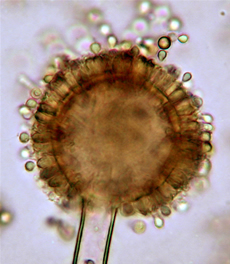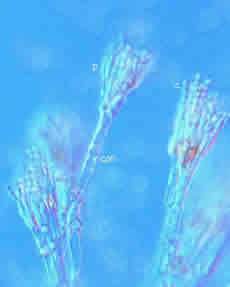Agriculture
Mitosporic fungi?also known as Deuteromycota, Deuteromycotina, fungi imperfecti, and deuteromycetes?are fungi that are unable to produce sexual spores and are therefore placed in a separate phylum.
The term ?mitosporic? is a combination of the words ?mitosis? and ?sporic.? Mitosis is the process of asexual cell division,which results in the daughter cells having the same genetic makeup as the mother cell.
?Sporic? is used to denote the creation of spores. Therefore, the fungi in Deuteromycota do not produce sexual spores. The groupings in this phylum are artificial.
Conidium
The asexual spore produced bymitosporic fungi is the conidium. Conidia are produced from cells called condiogenic cells without the combination of nuclei; therefore the conidia are a product of mitosis. The conidial phase is a repetitive one. Thousands of conidia can be produced under adequate environmental conditions. These conidia will then continue the repetitive cycle.
Parasexuality
The genetic content of most fungi is dikaryotic. Each fungal cell has two individual and genetically distinct haploid nuclei. This state is originally formed by the combination of haploid mycelia. During parasexuality, the formation of diploid nuclei occurs, and then these revert back to the haploid state. Parasexuality permits the exchange of genetic information between the two haploid nuclei.
The resultant haploid nuclei may be genetically modified. This is of great importance with plant pathogens, as parasexuality may help reduce genetic resistance of the host. Parasexuality is not considered to be a meiotic state, as no resultant sexual structure (such as an ascus or basidium) is formed.
Teleomorphs vs. Anamorphs
The teleomorph is the form of a fungus that occurswhen sexual reproduction has occurred. These forms are found in the Ascomycota and the Basidiomycota. The anamorph is the form of a fungus that occurs when no sexual recombination has occurred.
Anamorphs are important, as they are often a repetitive phase of the fungus and are able to produce spores without the additional requirement of sexual recombination.
When a specific teleomorph has been identified by scientists, the anamorphic phase is referred to as a subset of the teleomorph. For example, the anamorph fungus that produces blight of rice is known as Pyricularia oryzae. The teleomorph of this fungus is know as Magnaporthe grisea. The proper name for the anamorph is then the Pyricularia anamorph (or state) of Magnaporthe grisea.
Classification
Classification of the fungi in this group is based on the presence of conidia, kind of conidia (shape, color, size), and whether or not the conidia are produced in fungal structures called conidiomata.
Conidiomata may have the generalized shape of a flask made of fungal tissue (a pycnidium); a pin cushion (sporodochium); or a mass of conidiophores located under either the epidermis or cuticle of a plant host (aecervulus).
There are three classes in this grouping. The hyphomycetes contain the fungi that produce conidia and conidiophores on hyphae or groups of hyphae. The agonomycetes do not produce conidia. The coelomycetes contain the fungi that produce conidia in distinct conidiomata.
Classification is dependent on the fungus meeting the following requirements. First, there must be the absence or presumed absence of the teleomorph. Second, there may be the absence or presumed absence of any meiotic or mitotic reproductive structure (as in agonomycetes). Finally, there may be the production of conidia from mitosis. There must not be any sexual structures.
Challenges
One of the challenges of the classification of mitosporic fungi is that these are form-genera of fungi that include both fungi that do not have teleomorphic states and fungi that do.
For example, the teleomorph genus Cochliobolus has anamorphs in both the anamorphic form-genera Bipolaris and Curvularia. At the same time, there are several form species in both anamorphic genera Bipolaris and Curvularia that have no teleomorph stage.
The reason the teleomorph can be found in some species and not in others is not known. Some isolates of anamorph species are distinct mating types and can be crossed with the other distinct mating type. When distinct mating types occur, it is possible that over time the mating types could be separated or that one mating type could be destroyed.
Over time, without having the pressure to sexually reproduce, it is possible that the ability to sexually reproduce may have declined. Also, it is possible that the proper environmental conditions for sexual reproduction may not be known.
Whether these fungi are best covered in the form-phylum mitosporic fungi or the form-phylum Deuteromycota is a question that will continue to be discussed. Because only fungi that form sexual stages are recognized as legitimate species, the distinct species and genera of the anamorphic fungi will have to be covered in this artificial phylum.
- Ascomycetes
Ascomycetes The ascomycetes are fungi (phylum Ascomycota or Ascomycotina) that produce sexual spores in a specialized cell called an ascus. These diverse fungi, with more than thirty thousand species, can be found in almost every ecosystem worldwide....
- Basidioporic Fungi
Basidioporic FungiBasidiosporic fungi (also known as the Basidiomycota or Basidiomycotina) are fungi that produce sexual spores on a specialized cell called a basidium. The basidiosporic fungi are the most diverse phylum of the fungi world, with more...
- Fungi
FungiThe kingdom of non photosynthetic eukaryotic organisms, fungi are heterotrophic organisms, feeding on other materials rather than making their own food. They live on dead organisms by secreting digestive enzymes and absorbing the breakdown products....
- Ustomycetes
UstomycetesThe Ustomycetes are a group of the basidiosporic fungi that includes about a thousand species. These fungi all produce spores in a sorus, amass of spores that is produced on the surface of a plant host. Ustomycetes are all parasites of plants,...
- Yeast
YeastThe term ?yeast? does not refer to any recognized taxonomic name but instead describes fungi that are unicellular and usually reproduce asexually by budding. The term yeast is also used, more specifically, for those species in the genus Saccharomyces...
Agriculture
Mitosporic Fungi
 |
| Mitosporic Fungi |
The term ?mitosporic? is a combination of the words ?mitosis? and ?sporic.? Mitosis is the process of asexual cell division,which results in the daughter cells having the same genetic makeup as the mother cell.
?Sporic? is used to denote the creation of spores. Therefore, the fungi in Deuteromycota do not produce sexual spores. The groupings in this phylum are artificial.
Conidium
The asexual spore produced bymitosporic fungi is the conidium. Conidia are produced from cells called condiogenic cells without the combination of nuclei; therefore the conidia are a product of mitosis. The conidial phase is a repetitive one. Thousands of conidia can be produced under adequate environmental conditions. These conidia will then continue the repetitive cycle.
Parasexuality
 |
 |
The genetic content of most fungi is dikaryotic. Each fungal cell has two individual and genetically distinct haploid nuclei. This state is originally formed by the combination of haploid mycelia. During parasexuality, the formation of diploid nuclei occurs, and then these revert back to the haploid state. Parasexuality permits the exchange of genetic information between the two haploid nuclei.
The resultant haploid nuclei may be genetically modified. This is of great importance with plant pathogens, as parasexuality may help reduce genetic resistance of the host. Parasexuality is not considered to be a meiotic state, as no resultant sexual structure (such as an ascus or basidium) is formed.
Teleomorphs vs. Anamorphs
 |
| Teleomorphs vs. Anamorphs |
Anamorphs are important, as they are often a repetitive phase of the fungus and are able to produce spores without the additional requirement of sexual recombination.
When a specific teleomorph has been identified by scientists, the anamorphic phase is referred to as a subset of the teleomorph. For example, the anamorph fungus that produces blight of rice is known as Pyricularia oryzae. The teleomorph of this fungus is know as Magnaporthe grisea. The proper name for the anamorph is then the Pyricularia anamorph (or state) of Magnaporthe grisea.
Classification
Classification of the fungi in this group is based on the presence of conidia, kind of conidia (shape, color, size), and whether or not the conidia are produced in fungal structures called conidiomata.
Conidiomata may have the generalized shape of a flask made of fungal tissue (a pycnidium); a pin cushion (sporodochium); or a mass of conidiophores located under either the epidermis or cuticle of a plant host (aecervulus).
There are three classes in this grouping. The hyphomycetes contain the fungi that produce conidia and conidiophores on hyphae or groups of hyphae. The agonomycetes do not produce conidia. The coelomycetes contain the fungi that produce conidia in distinct conidiomata.
Classification is dependent on the fungus meeting the following requirements. First, there must be the absence or presumed absence of the teleomorph. Second, there may be the absence or presumed absence of any meiotic or mitotic reproductive structure (as in agonomycetes). Finally, there may be the production of conidia from mitosis. There must not be any sexual structures.
Challenges
 |
| running your car on water |
For example, the teleomorph genus Cochliobolus has anamorphs in both the anamorphic form-genera Bipolaris and Curvularia. At the same time, there are several form species in both anamorphic genera Bipolaris and Curvularia that have no teleomorph stage.
The reason the teleomorph can be found in some species and not in others is not known. Some isolates of anamorph species are distinct mating types and can be crossed with the other distinct mating type. When distinct mating types occur, it is possible that over time the mating types could be separated or that one mating type could be destroyed.
Over time, without having the pressure to sexually reproduce, it is possible that the ability to sexually reproduce may have declined. Also, it is possible that the proper environmental conditions for sexual reproduction may not be known.
Whether these fungi are best covered in the form-phylum mitosporic fungi or the form-phylum Deuteromycota is a question that will continue to be discussed. Because only fungi that form sexual stages are recognized as legitimate species, the distinct species and genera of the anamorphic fungi will have to be covered in this artificial phylum.
- Ascomycetes
Ascomycetes The ascomycetes are fungi (phylum Ascomycota or Ascomycotina) that produce sexual spores in a specialized cell called an ascus. These diverse fungi, with more than thirty thousand species, can be found in almost every ecosystem worldwide....
- Basidioporic Fungi
Basidioporic FungiBasidiosporic fungi (also known as the Basidiomycota or Basidiomycotina) are fungi that produce sexual spores on a specialized cell called a basidium. The basidiosporic fungi are the most diverse phylum of the fungi world, with more...
- Fungi
FungiThe kingdom of non photosynthetic eukaryotic organisms, fungi are heterotrophic organisms, feeding on other materials rather than making their own food. They live on dead organisms by secreting digestive enzymes and absorbing the breakdown products....
- Ustomycetes
UstomycetesThe Ustomycetes are a group of the basidiosporic fungi that includes about a thousand species. These fungi all produce spores in a sorus, amass of spores that is produced on the surface of a plant host. Ustomycetes are all parasites of plants,...
- Yeast
YeastThe term ?yeast? does not refer to any recognized taxonomic name but instead describes fungi that are unicellular and usually reproduce asexually by budding. The term yeast is also used, more specifically, for those species in the genus Saccharomyces...


